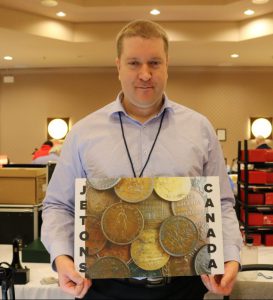By Jesse Robitaille
With a new editor comes new ideas and a new direction.
For the 10th edition of the Charlton Standard Catalogue of Canadian Colonial Tokens, Clément Chapados-Girard is at the helm of the transition. He takes over from long-running editor Jean Dale, who served since the catalogue’s sixth edition in 2007.
“It’s been pretty interesting because you can fix the errors that you’ve noticed and also take comments from other collectors to implement their changes and suggestions,” said Chapados-Girard, of Lévis, Qué., who’s also a dealer.
“It’s also not easy to do properly, but it’s my job to make sure most people are pleased, and to do it professionally.”

Dealer Clément Chapados-Girard, of Lévis, Qué., owns Jetons Canada and specializes in Canadian colonial tokens. He’s also the editor of the 10th edition of the Charlton Standard Catalogue Canadian Colonial Tokens.
NEW IDEAS
Now at 275 pages, the latest edition – released in late 2019 – includes a few major and extensive updates.
“I had questioned myself before I had the job of editor on ‘why is this here,’ or ‘why is this missing,’” said Chapados-Girard.
“While I found good reasons for many implemented ideas, I had my share of new ones.”
One was to add real images – rather than illustrations – for the “Bouquet” series, which was mainly in Lower Canada (present-day Québec) in the mid- to late-1830s. Most of this series now includes images of specimens for each of the varieties.
“There were slight differences between the drawings and the images that had collectors telling me they found new varieties. Those small differences might be a deal-breaker if a collector is looking to buy one, expensively, and thinks it’s unlisted.”
Another reason to use real images rather than illustrations is the latter can misrepresent the series’ strikes.
“Some are pretty weak and uneven,” said Chapados-Girard, of a token’s strike.
“For some pieces, it’s extremely rare to find the token as it’s imaged in the book, but I tried to chose the best pieces so collectors have an idea of what a nice piece looks like.”
Similarly, many other images were upgraded while others were corrected and more still were added to show unique pieces, he said.
CATALOGUE HISTORY
The first edition of the Charlton Standard Catalogue of Canadian Colonial Tokens was released in 1988 and ran 218 pages. Its content, which also included paper money, was removed from Charlton’s long-running coin catalogue in 1976. The second edition of the Charlton Standard Catalogue of Canadian Colonial Tokens followed in 1990, and five years later, the third edition was released. It was another half-decade before the release of the fourth – Millennium – edition in 2000. The next editions followed in 2003, 2007, 2010, 2012 and 2015.
FRESH MATERIAL
Like with all updated references, a major part of this 10th edition is the addition of fresh material.
The the “Bust and Harp” series’ varieties listed by late numismatist Eugene Courteau “finally made their way in,” said Chapados-Girard. They are now numbered from LC-60-1 to LC-60-26.
“All of the dies are different, and all of them have a little, unique trick added to the book to help people figure out which one they have,” he said, adding each individual pair of dies has its own number based on Courteau’s work.
“That’s an extensive change for that series.”
PRICING UPDATES
Other important changes include pricing updates to reflect the current market.
“It is a part of the book that was worked on for many hours as an up-to-date edition must be accurate on this matter,” said Chapados-Girard, who keeps a watchful eye on market prices as big-time token dealer.
“Because I sell the most regular tokens in Canada – I’m not talking about $2,000 and up, but regular tokens – I see the demand across the board. Also, since I’m always buying, I keep an eye on offers at auctions, shows and online, and it gives me a better idea of prices.”
If he has a token that’s listed in the catalogue at $20 but he’s able to sell it quickly and consistently for $35, “something is wrong,” Chapados-Girard said.
“That’s where the editor comes in and says this isn’t working.”
Some tokens “have time to test the market,” he added, but others are more scarce and might take longer to determine the true market reality.
“If I have three of the same token, I can put them online for $25, $35 and $45 and see how long it takes to get nearer to the reality of the market. The opposite is true as well; if I have four pieces listed for two years and they don’t sell, they’re priced too high.”
OLD NEWS
Another less-evident change in the 10th edition is the removal of some obsolete or unknown references.
This change came into being after a simple question from a knowledgeable token collector, Chapados-Girard said.
“He asked me, ‘What does the ‘Tr’ stand for?’ While I knew the name Trenaman, I never read his work and wasn’t familiar with it at all.”
Other “direly needed improvements” came in the form of corrections of past mistakes.
While the English edition was published in November 2019, the catalogue’s French edition will be released early this year.

